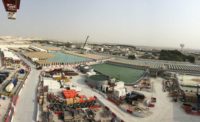Joe Crupi spent a recent morning standing between two sites where several long trenches had been dug to make way for installing part of the water distribution system to the Manhattan leg of Water Tunnel No. 3. Within one of the trenches, tangles of rusted pipes had already been lifted over wooden crossbeams and moved aside to make way for a new 48-in.-dia trunk main below. On this particular section of the project on this particular summer day, some of the old-pipe relocation work was done; crews were navigating the rest of the job.
Crupi, who is Upper Manhattan construction director at New York City's Dept. of Design and Construction (DDC), smiled wryly as he looked at the congested highway of private utility, electric, gas, cable TV, water and steam pipes and ducts in the city's underbelly. "This is what we find when we open up the streets. As you can see, there is no room for a 48-inch-diameter pipe," he said loud enough to be heard over the honking horns and screeching brakes of heavy traffic on 10th Avenue, which this project abuts. But he smiled again and added that below the pipe infrastructure "it looks like they made room."
It is that feat—making room for such an operation both below grade and above ground, where 10-ft-wide open cuts are made on New York's busy streets—that is one of the hardest parts of the city's decade-long $427-million project to install trunk and distribution water mains at 11 sites. DDC, which is performing the work for the Dept. of Environmental Protection (DEP), is managing 10 of the 11 sites and designed the trunk and water main projects in-house.
DEP, which manages the city's water supply, is undertaking work on the remaining site along with the activation phase of Tunnel No. 3's 8.5-mile Manhattan portion, which is slated to be turned on this fall. This portion of the tunnel begins under Central Park, runs down the West Side and, at the Holland Tunnel, loops to the East Side near Canal Street. Another branch of the tunnel runs east near 30th Street, loops up and ends near the Manhattan side of the Ed Koch Bridge.
Ten water tunnel shafts are located at intervals along that route. These shafts will bring water up to the distribution network. The trunk mains under construction will be attached to the shafts and the distribution mains connected to the trunk mains. Meanwhile, the next leg of Tunnel No. 3 is under construction in Queens and Brooklyn and is set for completion in 2018, says Edward Timbers, a DEP spokesman (see sidebar, below).
Tunnel No. 3, embedded 400 to 600 ft deep, will add redundancy to the city's water supply, which has been served by Tunnels No. 1 and 2, which were put into service in 1917 and 1936, respectively. Shutting down those older tunnels for repairs would also close the water supply to the city, so "someone had the foresight in 1970" to start work on the third tunnel, Crupi says. Once Tunnel No. 3 is activated, the older two tunnels can be shut off for repairs.
Current construction involves installing about 11 miles of distribution mains ranging in size from 12 in. to 20 in. in diameter, and 6.5 miles of trunk water mains ranging from 24 in. to 60 in. in diameter, says Thomas Foley, DDC assistant commissioner. For DDC's infrastructure division, this is its largest endeavor ever in both value and scope.
"This is a $427-million project, and $358 million of it is active right now," Foley says. "The $358 million is only the DDC side; there's a minimum of $350 million that the private utilities have to pay" for work on their underground facilities.
A project of this size that involves some of the busiest streets in Manhattan takes formidable coordination among numerous stakeholders, including private utilities like Con Edison and Verizon, Crupi says. These sites must be built on city-owned property, which means they are near other major infrastructure such as traffic tunnels and intersections, he says.
"We just finished one location just under the 59th Street Bridge, and to deal with traffic associated with that location was a big challenge," Crupi says.
At all sites, the rules are strict: At least one lane of traffic must be kept open; if water is shut off, it must be back on that night; and power cannot be down for any long period of time. Also, workers must initially do work by hand at some sites as heavy equipment might damage subsurface infrastructure.
The first contract began in 2009 downtown on Lafayette St., where a team led by Queens-based JLJ IV Enterprises Inc. made connections to tunnel Shaft 31B. This $13-million project was completed last May. The agency expects to let bids for four more trunk water main projects starting next year.
Last year, DDC embarked on the bulk of the project, awarding nearly $300 million in contracts. The largest of these is the five-year-long MED609, which includes contracts MEDs 599, 606, 609B and 610. The most challenging is MED609B, located on West 62nd Street from West End Avenue to Columbus Avenue—where Lincoln Center and Fordham University share a side street.
"This is different from a road and bridge project, which are usually set aside, outside of town," says David Frank, AECOM resident engineer inspector on MED609. "On this water main project, you're doing basically a [large] job in the middle of Lincoln Center and Fordham, so the coordination is exceptional."







Post a comment to this article
Report Abusive Comment